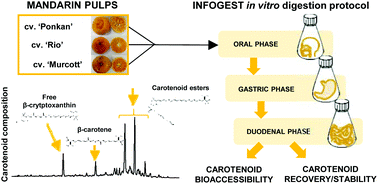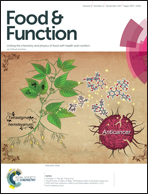Impact of in vitro digestion phases on the stability and bioaccessibility of carotenoids and their esters in mandarin pulps†
Abstract
The composition of carotenoids (carotenes and free and acylated xanthophylls) and their bioaccessibilities were determined for the first time in pulps of mandarins cultivated in Brazil. Two cultivars of mandarin, Citrus reticulata Blanco cv. ‘Ponkan’ and Citrus reticulata × C. sinensis cv. ‘Murcott’, showed higher contents of most carotenoids compared to those found in C. deliciosa Tenore cv. ‘Rio’. The major carotenoids in mandarin cv. ‘Ponkan’ and ‘Murcott’ were (all-E)-β-cryptoxanthin laurate (19–21%), (all-E)-β-cryptoxanthin myristate (15–17%) and (Z)-ζ-carotene (7–12%), followed by (all-E)-β-cryptoxanthin palmitate (4–7%), free (all-E)-β-cryptoxanthin (5–6%) and (all-E)-β-carotene (4–5%), while in mandarin cv. ‘Rio’ (all-E)-β-cryptoxanthin myristate (22%) was the major compound, followed by (all-E)-β-cryptoxanthin laurate (16%), (all-E)-β-cryptoxanthin palmitate (11%), (all-E)-β-cryptoxanthin (9%) and (all-E)-β-carotene (6%). After in vitro digestion, the qualitative carotenoid profile of the supernatant containing the micellarized carotenoids was similar to that of fresh fruits, but the contents were significantly lower. Carotenoid and mandarin physico-chemical properties influenced the bioaccessibility of carotenoids. Free (all-E)-β-cryptoxanthin showed the highest bioaccessibility in all mandarin cultivars (33–42%), while the bioaccessibilities of β-carotene (16–36%) and the major carotenoid esters (18–33%) were lower. The overall recovery of carotenoids during in vitro digestion was around 98% after the oral phase, 79% after oral + gastric phases and 77% after oral + gastric + duodenal phases, with free (all-E)-β-cryptoxanthin and (all-E)-β-carotene being the most stable ones. Besides possible E–Z isomerization and ester hydrolysis, evident losses occurred in total carotenoid contents and also in the most individual carotenoids and they were not compensated for by the former reactions.



 Please wait while we load your content...
Please wait while we load your content...